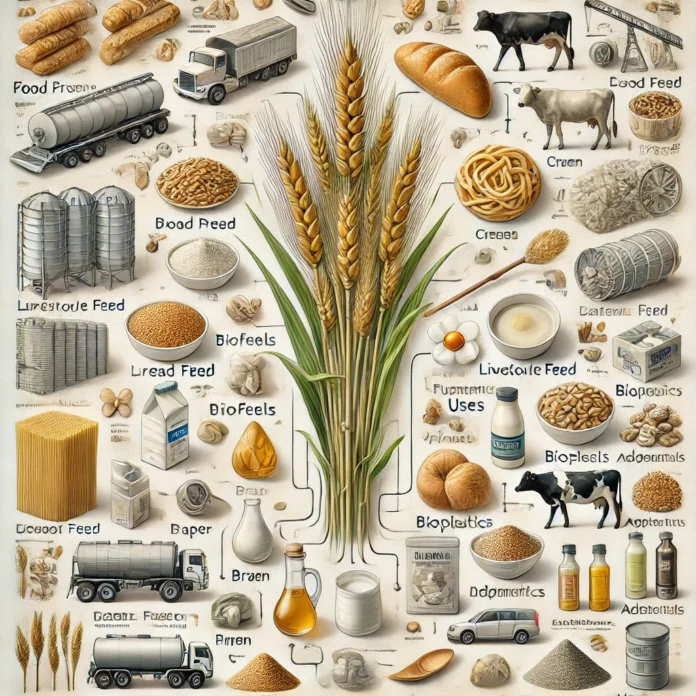Introduction
Wheat is a versatile crop, indispensable in global agriculture and trade. Its primary value lies in its adaptability, serving as a staple food and raw material across diverse industries. This report delves deeper into the specific roles wheat plays in food production, industrial applications, livestock feed, and more.
1. Food Production: Wheat as a Dietary Cornerstone
Details:
- Global Bread Production: Bread, a universal staple, accounts for nearly 70% of wheat flour usage worldwide.
- Specialized Wheat Types: Soft wheat for pastries; durum wheat for pasta.
- Healthier Options: Whole grain and multigrain wheat products are gaining popularity due to their health benefits.
Suggested Graphic:
A bar chart showing the percentage distribution of wheat usage in bread, pasta, cereals, and other food items globally.
2. Livestock Feed: Supporting Animal Agriculture
Details:
- Wheat Bran: A by-product of milling, it is rich in fiber and nutrients, ideal for livestock.
- Feed Blends: Wheat is mixed with other grains for balanced animal nutrition.
- Drought Resilience: Wheat silage is a sustainable option during periods of grain shortages.
Suggested Graphic:
A pie chart comparing the types of wheat-based feed products used in poultry, cattle, and swine farming.
3. Industrial Uses: Wheat’s Role Beyond the Plate
Details:
- Biofuels: Ethanol derived from wheat starch is a growing segment in renewable energy.
- Packaging: Wheat-based bioplastics reduce environmental impact compared to conventional plastics.
- Paper Production: Wheat straw pulp offers an eco-friendly alternative to wood pulp.
Suggested Graphic:
An infographic illustrating the process of converting wheat starch into ethanol, bioplastics, and paper pulp.
4. Pharmaceuticals and Nutraceuticals
Details:
- Cosmetics: Wheat germ oil is valued for its anti-aging and moisturizing properties.
- Health Foods: Wheatgrass juice and wheat germ are increasingly popular in health-focused diets.
- Medicinal Uses: Wheat starch enhances tablet consistency and durability.
Suggested Graphic:
A diagram showing cosmetic and pharmaceutical products made from wheat derivatives, such as creams, tablets, and supplements.
5. Cultural and Traditional Applications
Details:
- Culinary Staples: Wheat features prominently in Indian flatbreads, Italian pastas, and Middle Eastern pita bread.
- Symbolism: In many cultures, wheat symbolizes abundance and is used in celebratory dishes and rituals.
Suggested Graphic:
A world map highlighting wheat’s cultural significance with examples like chapati (India), baguettes (France), and pita (Middle East).
Global Wheat Industry: Key Insights
- Top Producers: The U.S., China, India, and Russia dominate global wheat production.
- Sustainability: Innovations like drought-resistant wheat and reduced pesticide use are improving sustainability.
- Market Trends: The growing demand for gluten-free alternatives and organic wheat products is reshaping the market.
Suggested Graphic:
A trend line chart showing the rise in demand for organic and gluten-free wheat products over the past decade.
SEO Tags:
wheat industry, wheat applications, wheat in food, wheat in cosmetics, wheat in biofuels, industrial uses of wheat, wheat in culture, wheat-based products, livestock feed wheat.
Conclusion
Wheat’s unparalleled versatility makes it a vital crop for sustaining global populations and industries. From the food on our plates to renewable energy solutions, wheat’s potential continues to expand. As sustainability and innovation drive the industry forward, wheat remains a key player in shaping our future.

